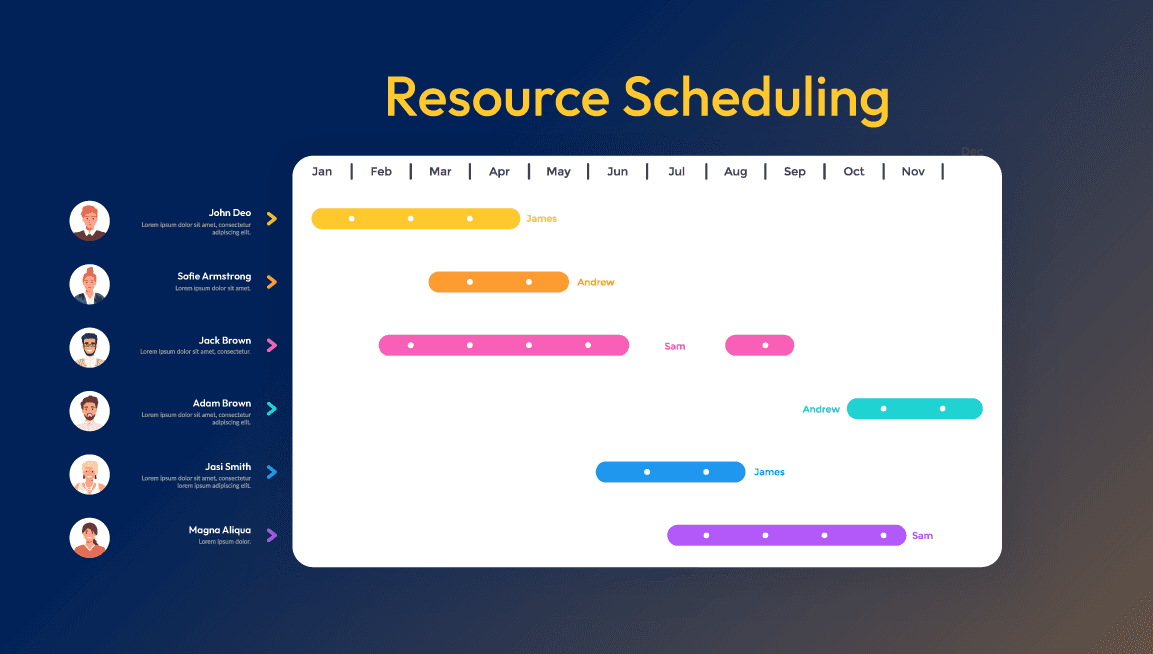Consider the following scenario: Imagine you’re tasked with overseeing the construction of an office building. The project is complex, involving numerous teams, materials, and deadlines. As the project progresses, you encounter unexpected delays, conflicting schedules, and resource shortages. Chaos ensues, and you find yourself struggling to keep the project on track and within budget.
This scenario highlights the critical role of resource scheduling in project management. It ensures that competently skilled resources are available at the right time and cost to accomplish project objectives efficiently.
In this blog, we’ll delve into the concept of resource scheduling and explore how it can significantly improve project delivery. Before delving deeper, let us try to understand what exactly resource scheduling is.
What is resource scheduling?
Resource scheduling involves assigning resources—whether they’re human, equipment, or materials—to tasks and activities within a project. These tasks can be both project and non-project activities, i.e., BAU, support, admin, operation, etc.
Let’s look at an example of a marketing campaign launch. This project consists of various tasks like content creation, graphic design, and more. With the help of effective resource scheduling, you can ensure that skilled resources like content writers, designers, and social media managers are deployed to their respective tasks.
Now, let us understand the importance of resource scheduling for businesses.
Significance of resource scheduling in project management
With effective resource scheduling, resources with the right level of skills and experience can be put to work on the tasks that require their expertise.
Let’s look at some aspects in which resource scheduling gives an upper hand to businesses:
Keeps project costs in check
Effective resource scheduling enables managers to assign employees based on skills, competencies, availability, etc., to various project activities, thereby preventing the deployment of under/over-skilled resources. Furthermore, it helps leverage global resources from low-cost locations strategically and aids in budget adherence.
Additionally, resource scheduling provides enough lead time for planned hiring or negotiates favorable contracts with vendors for a contingent workforce. Thus, it helps develop an appropriate resource mix, mitigating the risk of unnecessary cost escalations.
Deploys skilled resources to project tasks
By scheduling the right resources for the right task, firms can deliver projects within time and budget. The resource scheduling process enables managers to search and identify suitable project team members by assessing attributes like skills, competencies and availability, experience, qualification, role, cost rate, location, etc.
This enables them to deploy the rightly skilled resources to the right project tasks, thereby improving project quality and productivity. Since the right resources are working on the tasks, it minimizes the risk of errors and delays associated with mismatched skill sets.
Enhances employee engagement & productivity
Before resource scheduling, managers consider the employees’ current and future bookings, leaves, holidays, etc., to prevent any instances of overloading and double booking. In addition, they also view the overall utilization levels and check whether the resources are working on billable, non-billable, or strategic activities.
Based on this, supervisors mobilize resources from non-billable work to billable/strategic projects to improve their billable utilization and engagement. Since employees work on tasks where they can utilize their skills and expertise, it will automatically improve their performance and productivity.
Ensures timely delivery of high-quality projects
Each project has a predefined timeline, and managers must deliver the projects on time for client satisfaction and profitability. Resource scheduling enables project managers to deploy adequate, competent resources in advance for critical tasks.
Since it also considers team members’ capacity, it ensures balanced workload distribution. When the right resource is allocated to the right task, it guarantees seamless project execution and higher-quality deliverables. As a result, it leads to on-time project delivery.
Now, let us understand the steps to create an efficient resource scheduling process.
How to schedule resources for tasks effectively?
Here’s a breakdown of how to effectively schedule resources for tasks:
Assess the resource requirements for projects
Before scheduling resources for tasks, it’s crucial to conduct a comprehensive assessment of the resource requirements for the entire project. This includes gauging the types and quantities of resources needed, such as personnel, equipment, and materials. By understanding the project’s resource demands upfront, managers can gain insights into resource shortages or skill gaps. Accordingly, they can take necessary measures to mitigate the gaps.
For example- if there is a deficit of resources, they can leverage out-rotation and backfill strategy for critical resources or go for training/upskilling and even do planned hiring. This will ensure that required resources are available before the project’s onset, ensuring a smooth start.
Check resource capabilities and availability
Once the resource requirements are identified, the next step is to evaluate factors such as skill sets, experience levels, certifications, and the availability of resources within the specified timeframe. By ensuring that assigned resources possess the necessary skills and are available when needed, managers can ensure optimal resource utilization throughout the project lifecycle.
For example, a software development project requires a team of programmers proficient in various programming languages and frameworks. The manager identifies some resources and reviews their skill sets, experience levels, and certifications. Furthermore, the manager evaluates the availability of resources within the project timeline. They consider factors such as existing commitments, planned vacations, etc. This proactive approach contributes to the project’s success.
Assign resources to tasks accordingly
With a clear understanding of resource requirements and availability, managers can then assign resources to tasks based on their expertise and availability. This involves matching the right resources to the right tasks to maximize efficiency and productivity.
For instance, in software development, front-end design tasks involving crafting user interfaces require developers proficient in HTML, CSS, and JavaScript. By strategically assigning resources, project managers can optimize workflow, streamline task execution, and ensure that project milestones are completed on time and within budget.
Monitor and adjust resource schedules
Resource scheduling is not a one-time task but an ongoing process that entails continuous monitoring and adjustment. Project managers need to regularly review resource schedules, track resource utilization, and identify any deviations from the planned schedule. By monitoring resource schedules in real-time, project managers can proactively address issues such as resource conflicts, shortages, or overloads.
In case of resource overutilization, managers can implement optimization techniques like- resource leveling and smoothing. These techniques will respectively align the project timeline based on the availability of resources or pull in more resources from different departments to complete critical tasks. Thus, the continuous monitoring and adjustment of resource schedules enables the managers to respond effectively to project changes and ensure timely project completion.
Now, let’s look at some of the best practices for resource scheduling.
Additional tips for seamless resource scheduling
To ensure effective resource scheduling and maximize project efficiency, managers should consider implementing the following best practices:
- Sort projects by priority to mitigate scheduling conflicts and ensure that critical, high-priority tasks receive the necessary attention and resources.
- Avoid overbooking resources to prevent burnout and maintain productivity levels throughout the project lifecycle.
- Maintain transparent communication channels with team members regarding resource availability, task priorities, and any potential challenges or constraints.
- Leverage resource management tools equipped with resource scheduling functionalities to streamline the scheduling process and track utilization in real-time.
- Continuously evaluate and refine your resource scheduling processes based on lessons learned from past projects.
Conclusion
“Get the right people. Then no matter what else you might do wrong after that, the people will save you. That’s what management is all about.” ~ Tom DeMarco
Resource scheduling can make a world of difference and play a crucial role in the successful execution of any project. Thus, with strategic resource scheduling, you can streamline workflows, minimize risks, and achieve project success with confidence. Hence, businesses should implement a robust resource scheduling process that will help them enhance profitability and productivity and stay ahead of the competition.








